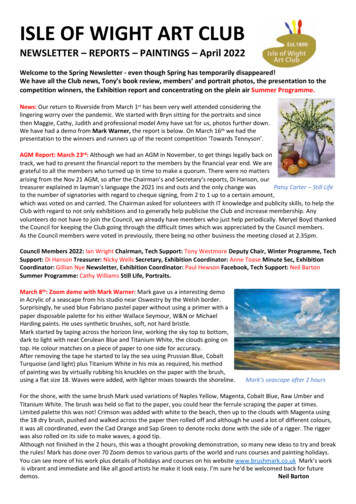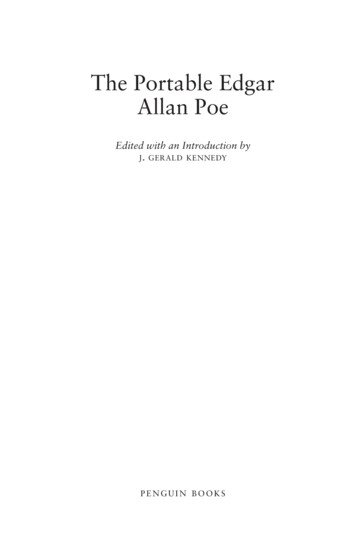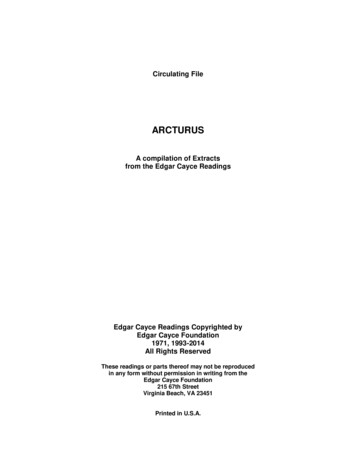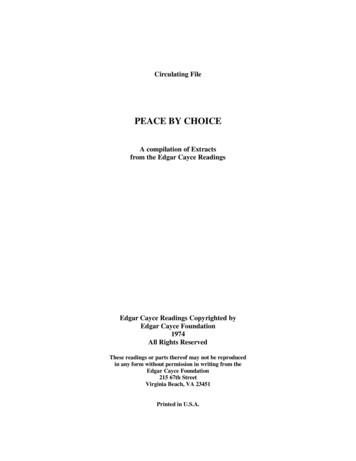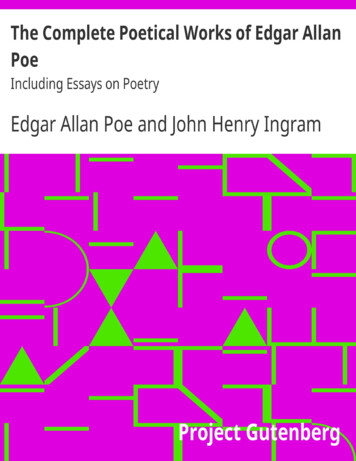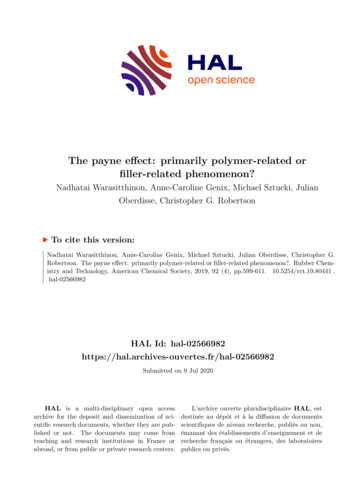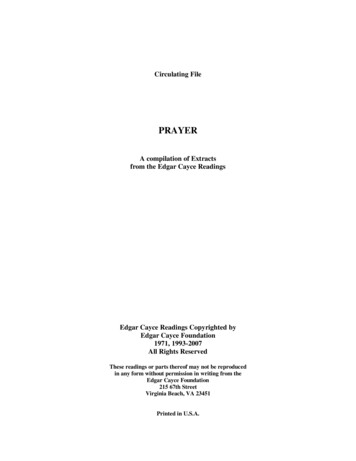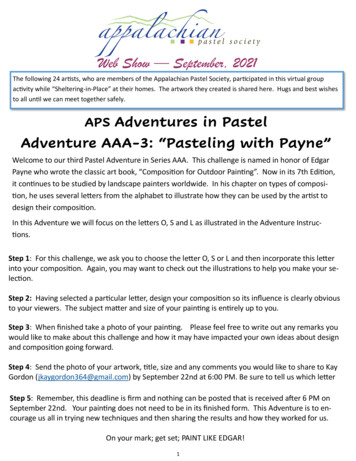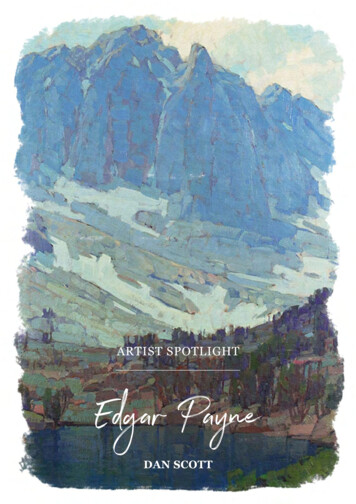
Transcription
ARTIST SPOTLIGHTEdgar PayneDAN SCOTT
Edgar PayneMaster of Landscape Composition and ColorWhen I think of landscape painting, one of the first artists who comes to mind is Edgar Payne. He was one of America’s most prominent landscape painters who had aremarkable eye for composition and color (he literally wrote what many consider tobe the book on landscape composition).Edgar Alwin Payne, Eucalyptus2
Key FactsHere are some interesting facts about Edgar Payne: He was born on 1 March 1883 in Missouri. He was largely a self-taught artist. He did enroll for a short period in the Art Institute of Chicago to study portrait painting, but dropped out after just two weeks ashe found it too structured. He got his first major commission in 1917 from Santa Fe Railroad as part of anadvertising campaign to attract tourism. This required Payne to explore and paintareas in the Southwest, including the Grand Canyon, Canyon de Chelly and Northern New Mexico. The commission helped establish Payne’s reputation as an artistand paved the way for the rest of his prolific career.Edgar Alwin Payne, Canyon de Chelly3
Some of his most famous works feature the Sierra mountains, which were a constant source of inspiration for him. He would often venture to the upper lakes ofthe Sierra Nevada on horse-back to paint. He even produced a documentary named“Sierra Journey”, but this is more for tourists rather than artists.Edgar AlwinPayne, Pack Trainin the High Sierra,1930s He becameso prolificthat a lakewas namedafter him.Edgar Payne, Payne Lake4
After the Santa Fe Railroad commission finished, he received a commission fromthe Congress Hotel in Chicago for an 11,000 square foot mural. In 1941 he wrote “Composition of Outdoor Painting”, a comprehensive guide tolandscape composition. This book is still considered by many artists to be the bookon landscape composition. It contains many composition theories and layoutswhich are fundamental in landscape painting today. He was married to Elsie Palmer Payne, who was a successful artist in her own right.It is safe to say her work was shadowed by the prolific career of Edgar. The coupleseparated in 1932, but she returned to him in his later years when he was battlingcancer. He passed in 1947.Edgar and Elsie Payne5
Style and TechniqueBreakdownPayne painted with a distinct, impressionist style. He probably owes part of his distinct style to his decision to go the self-taught route rather than the rigid, academicroute.Many of his paintings feature a strong use of shape. He was extremely good at breaking complex subjects down into really basic color shapes. This is particularly evidentin his paintings of mountains, like the one below. He used large brushes to paint distinct shapes of light and dark blue. This is very efficient brushwork. The end result isa very blocky style which seems to work well for the rigid mountains.Edgar Alwin Payne, Blue Shadows6
Here is anotherexample of his useof shape to paintmountains. Heoften broke themountains downinto distinct lightand dark shapes.Also, notice howhis brush seems tofollow the contourof the mountains.This helps reiterate the form.Edgar Alwin Payne, Hills of Altadena, 1917–1919Payne’s adventurous use of color is another signature aspect of his work. He pushedhis colors to create the illusion of light, often painting with rich oranges, blues andpurples like in the painting below. It is difficult to paint with this much color as it canend up looking garish if you overdo it.Edgar Alwin Payne, Sunset, Canyon De Chelly, 19167
He often painted strong contrasts between light and dark, or saturated and dull. In thepainting below, the dark foreground contrasts against the high-key colors in the background. Also, notice how he used light orange for the snow (not pure titanium white).Edgar Alwin Payne, The Shadow on the SlopeSometimes, Paynepainted with a morereserved color palette, like in thepainting belowwhich featuresmostly grays andother weak colors. Ipersonally prefer hismore vibrant paintings.Edgar Alwin Payne, The Rugged Slopes and Larch8
Payne did not only paint mountains and vast landscapes. The painting below featuresa close up of two beautiful yellow-leaved trees and a glimpse through to the light background. This is one of my favorite paintings by Payne and a perfect example of how topaint the illusion of light.Edgar Alwin Payne, Sycamore in Autumn, Orange County Park, c.1917He also painted many sailboats, in his signature style of solid color shapes.Edgar AlwinPayne,Boat SardinesEdgar Alwin Payne, Calm Sea9
The painting below demonstrates a beautiful depth, as it transitions from rich andrelatively dark colors in the foreground to weak and tinted colors in the background.Payne also seems to have used warmer colors in the foreground.Edgar Alwin Payne, Eucalyptus10
Edgar PayneSketchesI always enjoy looking at sketches and studies done by master artists. It gives you abehind-the-scenes look at how they worked. Here are some sketches by Payne:11
Edgar Payne Quotes“Art comes into being in that abstract interval between a thought and reality,and no one - not even the artist who created it - can remeasure theinfluences that caused it.”“The study of art is a lifetime matter. The best any artist can do is to accumulate all the knowledge possible of art and its principles, study nature often andthen practice continually.”“To be original one needs to learn the ideas of other painters in order to bedifferent from them.”“Learning the art of painting is not an easy task. It takes a great deal of intelligence, keen analysis, study and practice.”“The average artist, if he chooses, could render an exact drawing of what hesees. Artistic work not only allows but demands some deviation from form andline. Just how far this may go depends on the viewpoint of each painter.”12
When I think of landscape painting, one of the first artists who comes to mind is Ed-gar Payne. He was one of America's most prominent landscape painters who had a remarkable eye for composition and color (he literally wrote what many consider to be the book on landscape composition). Edgar Payne Master of Landscape Composition and Color
